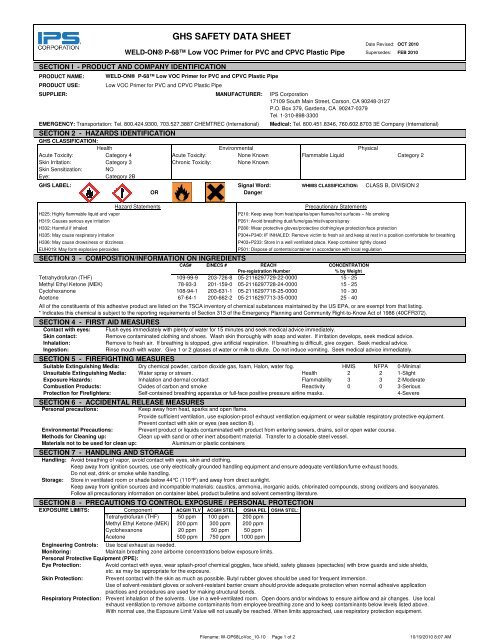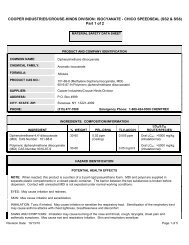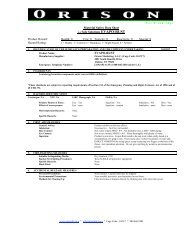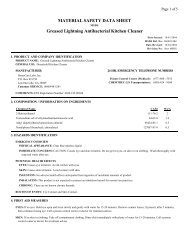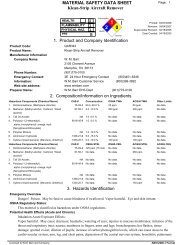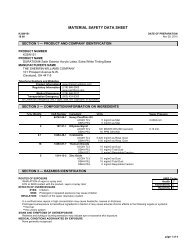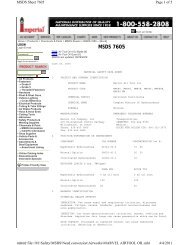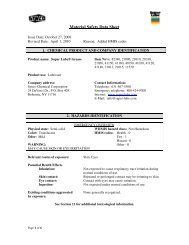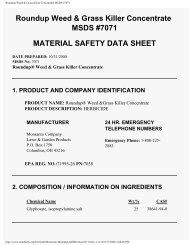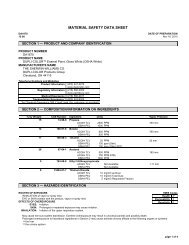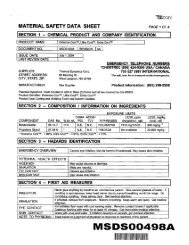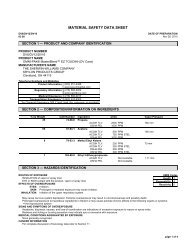GHS SAFETY DATA SHEET - IPS Corporation
GHS SAFETY DATA SHEET - IPS Corporation
GHS SAFETY DATA SHEET - IPS Corporation
Create successful ePaper yourself
Turn your PDF publications into a flip-book with our unique Google optimized e-Paper software.
Filename: W-OP68LoVoc_10-10 Page 1 of 2 10/19/2010 8:07 AM<strong>GHS</strong> <strong>SAFETY</strong> <strong>DATA</strong> <strong>SHEET</strong>WELD-ON® P-68 Low VOC Primer for PVC and CPVC Plastic PipeDate Revised: OCT 2010Supersedes: FEB 2010SECTION I - PRODUCT AND COMPANY IDENTIFICATIONPRODUCT NAME:PRODUCT USE:SUPPLIER:WELD-ON® P-68 Low VOC Primer for PVC and CPVC Plastic PipeLow VOC Primer for PVC and CPVC Plastic PipeMANUFACTURER:EMERGENCY: Transportation: Tel. 800.424.9300, 703.527.3887 CHEMTREC (International)<strong>IPS</strong> <strong>Corporation</strong>17109 South Main Street, Carson, CA 90248-3127P.O. Box 379, Gardena, CA 90247-0379Tel. 1-310-898-3300Medical: Tel. 800.451.8346, 760.602.8703 3E Company (International)SECTION 2 - HAZARDS IDENTIFICATION<strong>GHS</strong> CLASSIFICATION:Health Environmental PhysicalAcute Toxicity: Category 4 Acute Toxicity: None Known Flammable Liquid Category 2Skin Irritation: Category 3 Chronic Toxicity: None KnownSkin Sensitization: NOEye:Category 2B<strong>GHS</strong> LABEL: Signal Word: WHMIS CLASSIFICATION: CLASS B, DIVISION 2ORDangerH225: Highly flammable liquid and vapor P210: Keep away from heat/sparks/open flames/hot surfaces – No smokingH319: Causes serious eye irritation P261: Avoid breathing dust/fume/gas/mist/vapors/sprayH332: Harmful if inhaled P280: Wear protective gloves/protective clothing/eye protection/face protectionH335: May cause respiratory irritation P304+P340: IF INHALED: Remove victim to fresh air and keep at rest in a position comfortable for breathingH336: May cause drowsiness or dizziness P403+P233: Store in a well ventilated place. Keep container tightly closedEUH019: May form explosive peroxidesHazard StatementsSECTION 3 - COMPOSITION/INFORMATION ON INGREDIENTSPrecautionary StatementsP501: Dispose of contents/container in accordance with local regulationCAS# EINECS # REACHCONCENTRATIONPre-registration Number % by WeightTetrahydrofuran (THF) 109-99-9 203-726-8 05-2116297729-22-0000 15 - 25Methyl Ethyl Ketone (MEK) 78-93-3 201-159-0 05-2116297728-24-0000 15 - 25Cyclohexanone 108-94-1 203-631-1 05-2116297718-25-0000 10 - 30Acetone 67-64-1 200-662-2 05-2116297713-35-0000 25 - 40All of the constituents of this adhesive product are listed on the TSCA inventory of chemical substances maintained by the US EPA, or are exempt from that listing.* Indicates this chemical is subject to the reporting requirements of Section 313 of the Emergency Planning and Community Right-to-Know Act of 1986 (40CFR372).SECTION 4 - FIRST AID MEASURESContact with eyes: Flush eyes immediately with plenty of water for 15 minutes and seek medical advice immediately.Skin contact: Remove contaminated clothing and shoes. Wash skin thoroughly with soap and water. If irritation develops, seek medical advice.Inhalation:Remove to fresh air. If breathing is stopped, give artificial respiration. If breathing is difficult, give oxygen. Seek medical advice.Ingestion:Rinse mouth with water. Give 1 or 2 glasses of water or milk to dilute. Do not induce vomiting. Seek medical advice immediately.SECTION 5 - FIREFIGHTING MEASURESSuitable Extinguishing Media: Dry chemical powder, carbon dioxide gas, foam, Halon, water fog. HMIS NFPA 0-MinimalUnsuitable Extinguishing Media: Water spray or stream. Health 2 2 1-SlightExposure Hazards: Inhalation and dermal contact Flammability 3 3 2-ModerateCombustion Products: Oxides of carbon and smoke Reactivity 0 0 3-SeriousProtection for Firefighters: Self-contained breathing apparatus or full-face positive pressure airline masks. 4-SevereSECTION 6 - ACCIDENTAL RELEASE MEASURESPersonal precautions:Keep away from heat, sparks and open flame.Provide sufficient ventilation, use explosion-proof exhaust ventilation equipment or wear suitable respiratory protective equipment.Prevent contact with skin or eyes (see section 8).Environmental Precautions: Prevent product or liquids contaminated with product from entering sewers, drains, soil or open water course.Methods for Cleaning up:Clean up with sand or other inert absorbent material. Transfer to a closable steel vessel.Materials not to be used for clean up:Aluminum or plastic containersSECTION 7 - HANDLING AND STORAGEHandling: Avoid breathing of vapor, avoid contact with eyes, skin and clothing.Keep away from ignition sources, use only electrically grounded handling equipment and ensure adequate ventilation/fume exhaust hoods.Do not eat, drink or smoke while handling.Storage: Store in ventilated room or shade below 44°C (110°F) and away from direct sunlight.Keep away from ignition sources and incompatible materials: caustics, ammonia, inorganic acids, chlorinated compounds, strong oxidizers and isocyanates.Follow all precautionary information on container label, product bulletins and solvent cementing literature.SECTION 8 - PRECAUTIONS TO CONTROL EXPOSURE / PERSONAL PROTECTIONEXPOSURE LIMITS: Component ACGIH TLV ACGIH STEL OSHA PEL OSHA STEL:Tetrahydrofuran (THF) 50 ppm 100 ppm 200 ppmMethyl Ethyl Ketone (MEK) 200 ppm 300 ppm 200 ppmCyclohexanone20 ppm 50 ppm 50 ppmAcetone 500 ppm 750 ppm 1000 ppmEngineering Controls: Use local exhaust as needed.Monitoring:Maintain breathing zone airborne concentrations below exposure limits.Personal Protective Equipment (PPE):Eye Protection: Avoid contact with eyes, wear splash-proof chemical goggles, face shield, safety glasses (spectacles) with brow guards and side shields,etc. as may be appropriate for the exposure.Skin Protection: Prevent contact with the skin as much as possible. Butyl rubber gloves should be used for frequent immersion.Use of solvent-resistant gloves or solvent-resistant barrier cream should provide adequate protection when normal adhesive applicationpractices and procedures are used for making structural bonds.Respiratory Protection: Prevent inhalation of the solvents. Use in a well-ventilated room. Open doors and/or windows to ensure airflow and air changes. Use localexhaust ventilation to remove airborne contaminants from employee breathing zone and to keep contaminants below levels listed above.With normal use, the Exposure Limit Value will not usually be reached. When limits approached, use respiratory protection equipment.
Filename: W-OP68LoVoc_10-10 Page 2 of 2 10/19/2010 8:07 AMSECTION 9 - PHYSICAL AND CHEMICAL PROPERTIESAppearance:Clear or purple, thin liquidOdor: Ethereal Odor Threshold: 0.88 ppm (Cyclohexanone)pH:Not ApplicableMelting/Freezing Point: -108.5°C (-163.3°F) Based on first melting component: THF Boiling Range: 56°C (133°F) to 156°C (313°F)Boiling Point: 56°C (133°F) Based on first boiling component: Acetone Evaporation Rate: > 1.0 (BUAC = 1)Flash Point: -20°C (-4°F) TCC based on Acetone Flammability: Category 2Specific Gravity: 0.842 @23°C ( 73°F) Flammability Limits: LEL: 1.1% based on CyclohexanoneSolubility: Solvent portion soluble in water. Resin portion separates out. UEL: 12.8% based on AcetonePartition Coefficient n-octanol/water: Not Available Vapor Pressure: 190 mm Hg @ 20°C (68°F) AcetoneAuto-ignition Temperature: 321°C (610°F) based on THF Vapor Density: >2.0 (Air = 1)Decomposition Temperature: Not Applicable Other Data: Viscosity: Water-thinVOC Content:When applied as directed, per SCAQMD Rule 1168, Test Method 316A,VOC content is: < 550 g/l.SECTION 10 - STABILITY AND REACTIVITYStability:StableHazardous decomposition products: None in normal use. When forced to burn, this product gives off oxides of carbon and smoke.Conditions to avoid:Keep away from heat, sparks, open flame and other ignition sources.Incompatible Materials:Oxidizers, strong acids and bases, amines, ammoniaSECTION 11 - TOXICOLOGICAL INFORMATIONLikely Routes of Exposure:Inhalation, Eye and Skin ContactAcute symptoms and effects:Inhalation: Severe overexposure may result in nausea, dizziness, headache. Can cause drowsiness, irritation of eyes and nasal passages.Eye Contact: Vapors slightly uncomfortable. Overexposure may result in severe eye injury with corneal or conjunctival inflammation on contact with the liquid.Skin Contact: Liquid contact may remove natural skin oils resulting in skin irritation. Dermatitis may occur with prolonged contact.Ingestion: May cause nausea, vomiting, diarrhea and mental sluggishness.Chronic (long-term) effects: None known to humansToxicity: LD50 LC50Tetrahydrofuran (THF) Oral: 2842 mg/kg (rat) Inhalation 3 hrs. 21,000 mg/m 3 (rat)Methyl Ethyl Ketone (MEK) Oral: 2737 mg/kg (rat), Dermal: 6480 mg/kg (rabbit) Inhalation 8 hrs. 23,500 mg/m 3 (rat)Cyclohexanone Oral: 1535 mg/kg (rat), Dermal: 948 mg/kg (rabbit) Inhalation 4 hrs. 8,000 PPM (rat)Acetone Oral: 5800 mg/kg (rat) Inhalation 50,100 mg/m 3 (rat)Reproductive Effects Teratogenicity Mutagenicity Embryotoxicity Sensitization to Product Synergistic ProductsNot Established Not Established Not Established Not Established Not Established Not EstablishedSECTION 12 - ECOLOGICAL INFORMATIONEcotoxicity: None KnownMobility:In normal use, emission of volatile organic compounds (VOC's) to the air takes place, typically at a rate of < 550 g/l.Degradability: BiodegradableBioaccumulation: Minimal to none.SECTION 13 - WASTE DISPOSAL CONSIDERATIONSFollow local and national regulations. Consult disposal expert.SECTION 14 - TRANSPORT INFORMATIONProper Shipping Name:Flammable Liquid, n.o.s. (Acetone, Tetrahydrofuran)Hazard Class: 3Secondary Risk:NoneEXCEPTION for Ground ShippingIdentification Number: UN 1993 DOT Limited Quantity: Up to 1L per inner packaging, 30 kg gross weight per package.Packing Group: PG II Consumer Commodity: Depending on packaging, these quantities may qualify under DOT as "ORM-D" .Label Required:Class 3 Flammable LiquidMarine Pollutant:NOTDG INFORMATIONTDG CLASS: FLAMMABLE LIQUID 3SHIPPING NAME:Flammable Liquid, n.o.s. (Acetone, Tetrahydrofuran)UN NUMBER/PACKING GROUP: UN 1993, PG IISECTION 15 - REGULATORY INFORMATIONPrecautionary Label Information: Highly Flammable, Irritant Ingredient Listings: USA TSCA, Europe EINECS, Canada DSL, AustraliaSymbols: F, Xi AICS, Korea ECL/TCCL, Japan MITI (ENCS)Risk Phrases: R11: Highly flammable.R20: Harmful by inhalation. R66: Repeated exposure may cause skin dryness or crackingR36/37: Irritating to eyes and respiratory system.R67: Vapors may cause drowsiness and dizzinessSafety Phrases: S9: Keep container in a well-ventilated place. S26: In case of contact with eyes, rinse immediately with plenty of water and seek medical advice.S16: Keep away from sources of ignition - No smoking. S33: Take precautionary measures against static discharges.S25: Avoid contact with eyes. S46: If swallowed, seek medical advise immediately and show this container or label.SECTION 16 - OTHER INFORMATIONSpecification Information:Department issuing data sheet: <strong>IPS</strong>, Safety Health & Environmental Affairs All ingredients are compliant with the requirements of the EuropeanE-mail address: Directive on RoHS (Restriction of Hazardous Substances).Training necessary:Reissue date / reason for reissue:Intended Use of Product:Yes, training in practices and procedures contained in product literature.10/19/2010 / Updated <strong>GHS</strong> Standard FormatPrimer for PVC and CPVC Plastic PipeThis product is intended for use by skilled individuals at their own risk. The information contained herein is based on data considered accurate based on current state ofknowledge and experience. However, no warranty is expressed or implied regarding the accuracy of this data or the results to be obtained from the use thereof.


